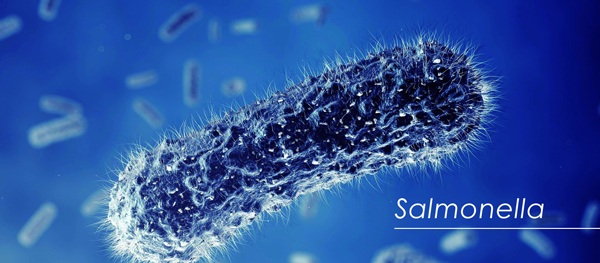Salmonella species are a leading cause bacteria diarrhea worldwide.
The Salmonella genus is divided taxonomically into six Salmonella enterica subspecies and Salmonella bongori. A total of 2500 different Salmonella serotypes have been identified up to 2004. Salmonella enteriditis and Salmonella typhimurium, the two most important serotypes for salmonellosis transmitted from animals to humans.

Salmonella causes two types of diseases: enteric (typhoid) fever and acute gastroenteritis commonly referred to as salmonellosis.
Transmission of Salmonella occurs through contaminated food (poultry, poultry products, beef, pork, eggs, milk, and seafood), water or contact with infected animals. Due to the ability of Salmonella to multiply in a wide variety of foods, it is important to be able to isolate the organisms even when present in very small numbers in the faeces.
The symptoms of Salmonella infection are abdominal pain, diarrhoea, mild fever, chills, headache, nausea and vomiting, developing 12–72 hours (but occasionally as long as 7 days) after infection. The discomfort generally lasts a few days. It can be dangerous for the elderly, infants and the immunocompromised, who may become extremely ill.
Salmonella is also one of the leading predictors for reactive arthritis, a painful, chronic and potentially debilitating condition that causes joint inflammation.
Available Certest screening tests for Salmonella:
Rapid Test:
- Salmonella Card Test
- Salmonella typhi Card Test
- Salmonella paratyphi Card Test
- Salmonella typhi + paratyphi Combo Card Test
VIASURE:
- VIASURE Salmonella Real Time PCR Detection Kit
- VIASURE Salmonella, Campylobacter & Y. enterocolitica Real Time PCR Detection Kit
- VIASURE Salmonella, Campylobacter & Shigella/EIEC Real Time PCR Detection Kit
- Gastrointestinal Panel I
- Gastrointestinal Panel II
- Gastrointestinal Panel III
- Gastrointestinal Panel IV
bioSCIENCE:
For Salmonella paratyphi A detection:
- MT-18SPA27 – Anti-Salmonella paratyphi Mab (clone SPA27) (x1mg)
- MT-28SPAU – Inactivated Salmonella paratyphi A antigen (native extract) (x1ml)
For Salmonella typhi detection:
- MT-18ST25 – Anti-Salmonella typhi Mab (clone ST25) (x1mg)
- MT-28STU – Inactivated Salmonella typhi antigen (native extract) (x1ml)
For Salmonella paratyphi B and typhimurium detection:
- MT-18SB2 – Anti-Salmonella group B Mab (clone SB2) (x1mg)
- MT-28STMU – Inactivated Salmonella typhimurium antigen (native extract) (x1mg)
- MT-28SPBU – Inactivated Salmonella paratyphi B antigen (native extract) (x1ml)
For Salmonella enteriditis detection:
- MT-18SE24 – Anti-Salmonella enteriditis Mab (clone SE24) (x1mg)
- MT-28SEU – Inactivated Salmonella enteritidis antigen (native extract) (x1ml)
